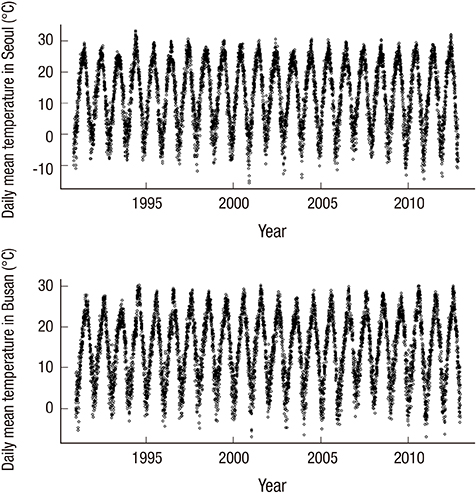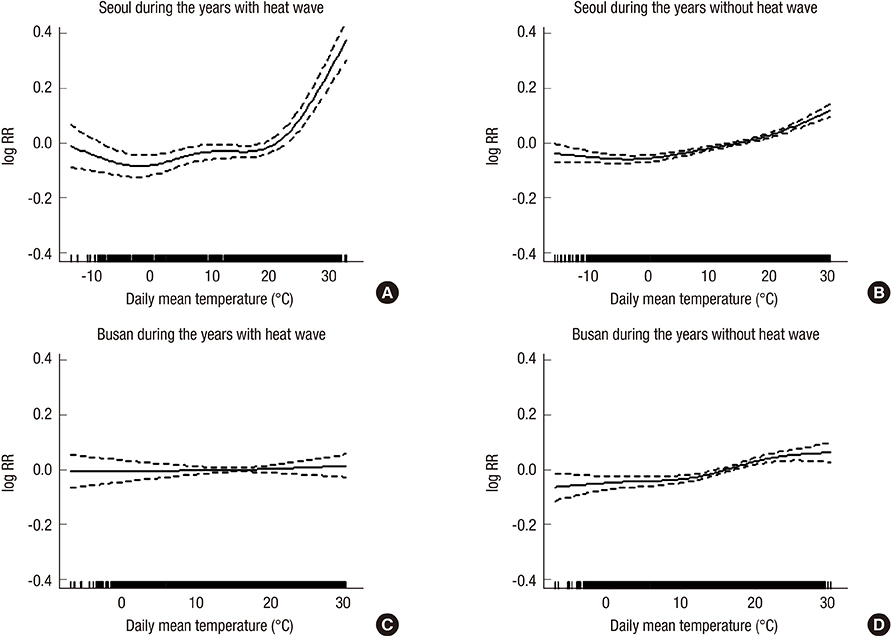J Korean Med Sci.
2016 May;31(5):702-708. 10.3346/jkms.2016.31.5.702.
Modifying Effect of Heat Waves on the Relationship between Temperature and Mortality
- Affiliations
-
- 1Department of Social and Preventive Medicine, Inha University School of Medicine, Incheon, Korea.
- 2Department of Preventive Medicine, School of Medicine, Ewha Womans University, Seoul, Korea. hpark@ewha.ac.kr
- KMID: 2373666
- DOI: http://doi.org/10.3346/jkms.2016.31.5.702
Abstract
- Studies conducted to evaluate temporal trends of heat-related mortality have not considered the effects of heat waves; although it is known they can affect mortality and act as a modifying factor. After adjusting for long-term trends and seasonality, the effects of temperature on non-accidental deaths in Seoul and Busan (inland and coastal cities, respectively) were analyzed using a generalized additive model of Poisson distribution. We evaluated temporal trends of heat-related mortalities in four periods (1991-1995, 1996-2000, 2001-2005, and 2006-2012). The effects of temperature on mortality were evaluated according to the occurrence of a heat wave and results were compared in the two cities. The effect of temperature on mortality was the greatest in 1991-1995 in Seoul; no significant change was observed in Busan. When we stratified the study period by heat wave status, the risk increase in mortality was 15.9% per 1℃ during years with a heat wave in Seoul, which was much higher than 0.31% increase observed during years without a heat wave. On the other hand, Busan showed a linear relationship between temperature and mortality and no significant difference between years with or without a heat wave. Variations in the relationship between temperature and mortality could be misunderstood if heat waves are not considered. Furthermore, heterogeneity was found in the modifying effect of heat waves on heat-related mortality in inland and coastal cities. The findings of this study help understand relations between temperature and mortality.
Keyword
Figure
Reference
-
1. Hansen J, Sato M, Ruedy R. The new climate dice: public perception of climate change. accessed on 1 August 2015. Available at http://www.columbia.edu/~jeh1/mailings/2012/20120803_DicePopSci.pdf.2. Basu R, Feng WY, Ostro BD. Characterizing temperature and mortality in nine California counties. Epidemiology. 2008; 19:138–145.3. Anderson BG, Bell ML. Weather-related mortality: how heat, cold, and heat waves affect mortality in the United States. Epidemiology. 2009; 20:205–213.4. Hajat S, Kosatky T. Heat-related mortality: a review and exploration of heterogeneity. J Epidemiol Community Health. 2010; 64:753–760.5. Barnett AG. Temperature and cardiovascular deaths in the US elderly: changes over time. Epidemiology. 2007; 18:369–372.6. Davis RE, Knappenberger PC, Novicoff WM, Michaels PJ. Decadal changes in summer mortality in U.S. cities. Int J Biometeorol. 2003; 47:166–175.7. Guo Y, Barnett AG, Tong S. High temperatures-related elderly mortality varied greatly from year to year: important information for heat-warning systems. Sci Rep. 2012; 2:830.8. Hajat S, Armstrong B, Baccini M, Biggeri A, Bisanti L, Russo A, Paldy A, Menne B, Kosatsky T. Impact of high temperatures on mortality: is there an added heat wave effect? Epidemiology. 2006; 17:632–638.9. Anderson GB, Bell ML. Heat waves in the United States: mortality risk during heat waves and effect modification by heat wave characteristics in 43 U.S. communities. Environ Health Perspect. 2011; 119:210–218.10. Bobb JF, Peng RD, Bell ML, Dominici F. Heat-related mortality and adaptation to heat in the United States. Environ Health Perspect. 2014; 122:811–816.11. Meehl GA, Tebaldi C. More intense, more frequent, and longer lasting heat waves in the 21st century. Science. 2004; 305:994–997.12. Li T, Horton RM, Kinney P. Future projections of seasonal patterns in temperature-related deaths for Manhattan. Nat Clim Chang. 2013; 3:717–721.13. Korea Meteorological Administration. accessed on 1 March 2015. Available at http://web.kma.go.kr/eng/index.jsp.14. Statistics Korea. Microdata Integrated Service. accessed on 1 March 2015. Available at http://mdss.kostat.go.kr/mdssext/index.jsp.15. Frich P, Alexander LV, Della-Marta P, Gleason B, Haylock M, Klein Tank AM, Peterson T. Observed coherent changes in climatic extremes during the second half of the twentieth century. Clim Res. 2002; 19:193–212.16. World Health Organization. The global burden of disease: 2004 update. accessed on 1 October 2015. Available at http://www.who.int/healthinfo/global_burden_disease/GBD_report_2004update_full.pdf.17. Carson C, Hajat S, Armstrong B, Wilkinson P. Declining vulnerability to temperature-related mortality in London over the 20th century. Am J Epidemiol. 2006; 164:77–84.18. Petkova EP, Gasparrini A, Kinney PL. Heat and mortality in New York City since the beginning of the 20th century. Epidemiology. 2014; 25:554–560.19. Lim YH, Kim H, Hong YC. Variation in mortality of ischemic and hemorrhagic strokes in relation to high temperature. Int J Biometeorol. 2013; 57:145–153.20. Lee S, Kim H, Yi SM. The relationships between temperature changes and mortality in Seoul, Korea. J Environ Health Sci. 2010; 36:20–26.21. Rocklov J, Barnett AG, Woodward A. On the estimation of heat-intensity and heat-duration effects in time series models of temperature-related mortality in Stockholm, Sweden. Environ Health. 2012; 11:23.22. Martin SL, Cakmak S, Hebbern CA, Avramescu ML, Tremblay N. Climate change and future temperature-related mortality in 15 Canadian cities. Int J Biometeorol. 2012; 56:605–619.23. Medina-Ramón M, Schwartz J. Temperature, temperature extremes, and mortality: a study of acclimatisation and effect modification in 50 US cities. Occup Environ Med. 2007; 64:827–833.24. Curriero FC, Heiner KS, Samet JM, Zeger SL, Strug L, Patz JA. Temperature and mortality in 11 cities of the eastern United States. Am J Epidemiol. 2002; 155:80–87.25. Xiao J, Peng J, Zhang Y, Liu T, Rutherford S, Lin H, Qian Z, Huang C, Luo Y, Zeng W, et al. How much does latitude modify temperature-mortality relationship in 13 eastern US cities? Int J Biometeorol. 2015; 59:365–372.26. United States Environmental Protection Agency. Heat island impacts. assessed on 1 October 2015. Available at http://www.epa.gov/heatisland/impacts/index.htm#health.27. Goggins WB, Chan EY, Ng E, Ren C, Chen L. Effect modification of the association between short-term meteorological factors and mortality by urban heat islands in Hong Kong. PLoS One. 2012; 7:e38551.28. Gabriel KM, Endlicher WR. Urban and rural mortality rates during heat waves in Berlin and Brandenburg, Germany. Environ Pollut. 2011; 159:2044–2050.29. Vandentorren S, Bretin P, Zeghnoun A, Mandereau-Bruno L, Croisier A, Cochet C, Ribéron J, Siberan I, Declercq B, Ledrans M. August 2003 heat wave in France: risk factors for death of elderly people living at home. Eur J Public Health. 2006; 16:583–591.30. Smargiassi A, Goldberg MS, Plante C, Fournier M, Baudouin Y, Kosatsky T. Variation of daily warm season mortality as a function of micro-urban heat islands. J Epidemiol Community Health. 2009; 63:659–664.31. Kim YH, Baik JJ. Daily maximum urban heat island intensity in large cities of Korea. Theor Appl Climatol. 2004; 79:151–164.32. Chung JY, Honda Y, Hong YC, Pan XC, Guo YL, Kim H. Ambient temperature and mortality: an international study in four capital cities of East Asia. Sci Total Environ. 2009; 408:390–396.
- Full Text Links
- Actions
-
Cited
- CITED
-
- Close
- Share
- Similar articles
-
- Characteristics of Heat Waves From a Disaster Perspective
- The Impact of High Apparent Temperature on the Increase of Summertime Disease-related Mortality in Seoul: 1991-2000
- Summertime Heat Waves and Ozone : an Interaction on Cardiopulmonary Mortality? - Based on the 1994 Heat Wave in Korea -
- Effects of the 2018 heat wave on health in the elderly: implications for adaptation strategies to climate change
- Comparison of Temperature Indexes for the Impact Assessment of Heat Stress on Heat-Related Mortality




